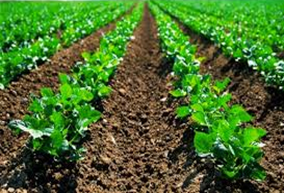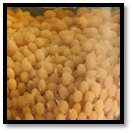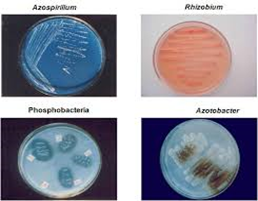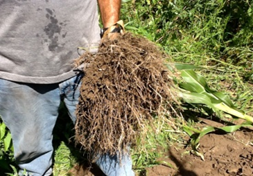Technologies
Agriculture
1. RT-PCR based Bt-Gene quantification assay & Kit
Value Proposition
- Determination of percent GMO food content important for import / export regulations.
- Highly specific and sensitive
- Ability to differentiate the GM cotton in seed level
- Cost effective and fast in comparison to existing end point techniques.

2. Liquid Bio-fertilizer for Eco-Friendly and Sustainable Agriculture
-
A cost effective Bio-fertilizer for field applications
BackgroundBio-fertilizers are artificially multiplied cultures of certain soil organisms that can improve soil fertility and crop productivity. Bio-fertilizers can be categorized into three major classes:
- Nitrogen-Fixation
- Phosphorus-Solubilizing
- Potash -Solubiliser
Bio-fertilizer are used for enhancing the productivity of the soil. They fix atmospheric nitrogen and solubilize phosphorus. Also they stimulate plant growth through synthesis of plant growth promoting substances. Liquid Bio-fertilizers have a distinct advantage in terms of cost saving on chemical fertilizers in addition to yield advantage. Chemical fertilizers otherwise may have negative effects on soil as well as human health, change the soil chemistry and these soils no longer support plant growth in the long run.TechnologyGujarat Biotechnology Research Centre has developed liquid bio-fertilizers from strains of Bank-A-Bug repository and screened them for Nitrogen-Fixation, Phosphorus-Solubilizing, Potash –Solubilising properties.Potential ApplicationsThere are three ways of using Liquid Bio-fertilizers- Seed treatment
- Root dipping
- Soil application
BenefitsAssay has been tested in multiple Bt-cotton accessions and validated- Eco Friendly
- Effective and Efficient used in organic farming
- Shelf life minimum 1 year
- Easy use and transport
- Suitable for drip irrigation
- Suitable for Green house technology
Technology StatusTechnology is ready and can be packed in different volumes and combinations as per requirement

3. Eco-friendly Sustained Release Nitrogen Biofertilizer
-
A effective Sustained release biofertilizer
Background
Inoculation of Plant for non-symbiotic rhizosphere bacteria for crop improvement is complicated task. A slow-release fertilizer releases nutrients to plants slowly over some time. Slow-release fertilizers are usually dry blends or granular formulas, they are easy to spread and are suitable for covering broad areas.
Sustained release fertilizer has a distinct advantage in terms of cost saving on chemical fertilizers and liquid biofertilizer in addition to yield advantage. Chemical slow release fertilizers otherwise may have negative effects on soil and change the soil chemistry and these soils no longer support plant growth in the long run and these limitations of chemical slow release fertiliser and liquid biofertilizer led to exploration of sustained release biofertilizer
Slow-release fertilizers release their nutrients slowly after each irrigation. The benefits to the farmer are that the plants don't receive toxic amounts of fertilizers all at once.Technology
Gujarat Biotechnology Research Centre has developed Bead trapped with bacterial culture as Sustained release fertilizer by screening of different Strains of Nitrogen fixer for its Nitrogen fixing ability from Bank a Bug repository. Complete technology for the production is based on immobilization of Nitrogen fixing bacteria in a matrix which is ecofriendly and helps in sustained release of bacteria in soil thus, rendering fertility for longer period.Potential Applications
This can be used in following ways
- Sowing with Seed
- Spreading on surface of turfs and lawns
- With roots of plants
Advantages

- Prevents Volatilization, Denitrification, Leaching and Run off of Nitrogen from Soil
- No problem of toxic residue
- long persisting effect
- Conventional technique of application
Technology Status
The processes are developed and can be packed bulk on requirement
4. Mycorrhizal Bio-fertilizer
-
A cost effective bio-fertilizer for promoting growth and enhanced nutrient uptake
especially phosphorous
Brief Description
India consumes about 17.8 million tonnes of fertilizer per annum to meet the food security requirements. Overuse of fertilizers has led to nutrient leaching, environmental and human health problems, from climate change and dead zones in the oceans to cancer and reproductive risk. Agrarian economy is also suffering. The need of the hour is to switch to cost effective, environment friendly bio fertilizers to prevent further damage.Technology
Gujarat Biotechnology Research Centre has developed a mycorrhizal biofertilizer which contains ample infective propagules that can result in the production of a plant of great vigor. The mycorrhizal biofertilizer helps in establishing a mutualistic association between plants and many of fungi from the phylum Glomeromycota. Upon colonizing the roots, arbuscular mycorrhizal fungi (AMF) gives rise to hypha which act as vehicle for nutritional exchange aiding in mobilizing uptake of phosphorous (beyond depleted zone), micronutrients and other untapped nutrition in the soil. It will help in improving soil texture and structure and increase resistance against diseases, drought, salinity, heavy metals and other abiotic stresses. It will also help in withstanding transplant shock during hardening of tissue cultured raised plants.
As soon as the plant environment changes from sterile compost to soil, the root environment changes radically which can lead to plant failure and poor growth. In most soils, there are not enough of native mycorrhizal fungi close to the new plants roots to colonize fast enough to achieve the benefits of complete colonization. A new plant with fully functioning mycorrhiza root system will be most rewarding organic systemProblem Addressed
India consumes about 17.8 million tonnes of fertilizer per annum to meet the food security requirements. Overuse of fertilizers has led to nutrient leaching, environmental and human health problems, from climate change and dead zones in the oceans to cancer and reproductive risk. Agrarian economy is also suffering. The need of the hour is to switch to cost effective, environment friendly bio fertilizers to prevent further damage.
As soon as the plant environment changes from sterile compost to soil, the root environment changes radically which can lead to plant failure and poor growth.
In most soils, there are not enough of native mycorrhizal fungi close to the new plants roots to colonize fast enough to achieve the benefits of complete colonization.
A new plant with a fully functioning mycorrhizal root system will be the most rewarding and symbiotic association will lead to reduction of chemical fertilizer and pesticide inputs.Potential Applications
It is suitable for organic farming and commercial agricultural practices.Method of Application
Soil Application: Mix 2 to 4 Kg of Mycorrhizal bio-fertilizer with 100 Kgs of Organic Manure/vermi compost or dried farm yard manure and broadcast in the main field just before sowing / transplanting or apply in root zone of standing crop by row or spot or broadcasting method (50 g / plant). This method can also be used for lawn making.
Drip/drench Irrigation: Mix 2 kg mycorrhizal biofertilizer with sufficient quantity of water and apply in one-acre soil rhizosphere by drench or drip application.
Nursery application: The inoculum (20gm/plant) can be applied at 2-3 cm below the soil level at the time of sowing.
Polybag seedlings (10 kg of mycorrhizal biofertilizer for 1000 kg of potting mixture)USP/Advantages
- Cost effective as compared to existing mycorrhizal bio-fertilizer.
- Effective for wide spectrum of agricultural/ forestry crop
- User and environment friendly
IP status
Available for licensingTechnology Status
Bio fertilizer will be

5. Kit for sex determination in date palm
Background
The Date palm (Phoenix dactylifera L.) is one of the chief flowering plants included in the family of Arecaceae. In India, the area for date palm cultivation is around 18286 ha with 171522 MT production. In India, date palm is cultivated among the major parts Kutch region of Gujarat and few regions of Rajasthan. In date palm is dioecious plant in which inflorescence has male and female flowers on different plant. Traditionally, Date palm plants are produced from seed, and because of dioecious nature, seed produced plants contain approximately the same number of males and females plants. Additionally, only female plants produced fruits, and few male plants were needed only for pollination and fertilization with female ovules. Hence, the selection of female plants is the most crucial procedure for the economic cultivation of date palms. The sex of seedlings can be find out only in the flowering stage and it produces mostly at the age of 4-8 years of the plant. So, the initial gender determination of date palm is very important for farmers for increasing profits.
Technology
GBRC has developed DNA based molecular technique to detect sex of the plant at very early age. The technique very robust and based on simple PCR test. PCR based sex determination of date palm with Glycerol-3 phosphate acetyl transferase (GPAT3) male specific primer and LOX5.1 as positive control. GPAT3 plays important role in male fertility. According to results GPAT3 amplification only occur in male date palm samples, not in female. So that, if result of PCR amplification produced two bands than male and if one band than it is female.
- The sex determination of seedlings at early stage could help to improve breeding efforts by generating experimental gender specific genetic pools that will promote date palm genetic improvement.
- It also helps to farmers for removing unwanted extra male plants at seedling stage and by which it can increase production of date palm.
6. Detection of adulteration in herbal formulations
- Development of assay kit for detection of botanical adulterants in highly traded herbal products through DNA tags and barcoding
Background
Botanical adulteration is one of the most prevalent issues in herbal pharmacovigilance due to high demand and commerce. The key research gap is the limitation of analytical methods to authenticate plant material, which is mainly low resolution power at species level due to environmental influence, processing and storage conditions, and cryptic taxa morphology and chemical constitution. To combat this, Chinese and British pharmacopoeia are advocating DNA-based molecular authentication for herbal products, as DNA is a more stable and readily available moiety. The Ayurveda pharmacopoeia of India (API) has microscopic, macroscopic, and chemical-based analytical methods to authenticate medicinal plants and herbal formulations. We need to develop and promote DNA-based authentication methods in pharmacovigilance to meet accurate and high worldwide standards.
Technology
To authenticate herbal products, we used two methods: species-specific primers and metabarcoding. For herbal formulations such as Tulsi, Brahmi, Mari, Harde, Baheda, Amala, Arjuna, Ashwgandha, Kariyatu, and Gokshru,
traditional PCR methods (simplex and multiplex) have been developed. We designed in house rbcL and ITS2 minibarcodes for metabarcoding herbal formulations and validated them with different control pools and formulations such as Triphala, Trikatu, Hingvashatk, Rasayana, Sitopladi, Gokshru, and Brahmi.


